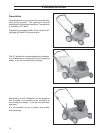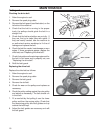
15
Blade versatility
Flail blade
Thatch is the dense layer of clippings, roots and
stems that forms between the soil and the base of
the grass. As thatch builds up, it prevents water,
air and fertilizer from being absorbed into the soil.
This causes shallow root development leading to
vulnerability to drought and frost. Excessive thatch
also creates an ideal environment for insects and
lawn diseases. Power-raking with flail blades
removes this thatch layer and restores your lawn
to good health. Flail blades offer the most
aggressive dethatching of all the blades offered.
Delta blade
Delta blades were created primarily for overseeding
existing lawn. They effectively incorporate grass
seed into the soil. This is an easy, reliable method
for rejuvenating poor lawns. The delta blade is also
useful as a vertical mower for cutting running stem
grasses and opening up the soil to oxygen, water,
nutrients and other chemicals. Delta blades are also
beneficial on slopes, terraces and in high clay
content soils where water runoff is a problem.
Blades should penetrate the soil to a depth of 1/8"
to 1/4" with a maximum penetration of 1/2". Check
your seed bag for the manufacture’s recommended
depth of application.
Spring tine
Ideal for the established lawn that is not in need
of a complete renovation but requires dethatching
(dry-spots, fungus, etc.). Spring tines are
designed to pluck dead grass and thatch out of
the lawn without tearing or damaging existing root
structure. With the flexible tines, the lawn is
combed only 3/16" into the soil, so it cannot
penetrate the root structure. Spring tines provide
less aggressive dethatching than flail blades.
Setting blade height
The blades are raised and lowered using a depth
lever on the right side of the machine. The knob in
front of the lever controls the depth. Turning the
knob counterclockwise increases blade depth.
CONTROLS
DEPTH LEVER
DEPTH KNOB


















